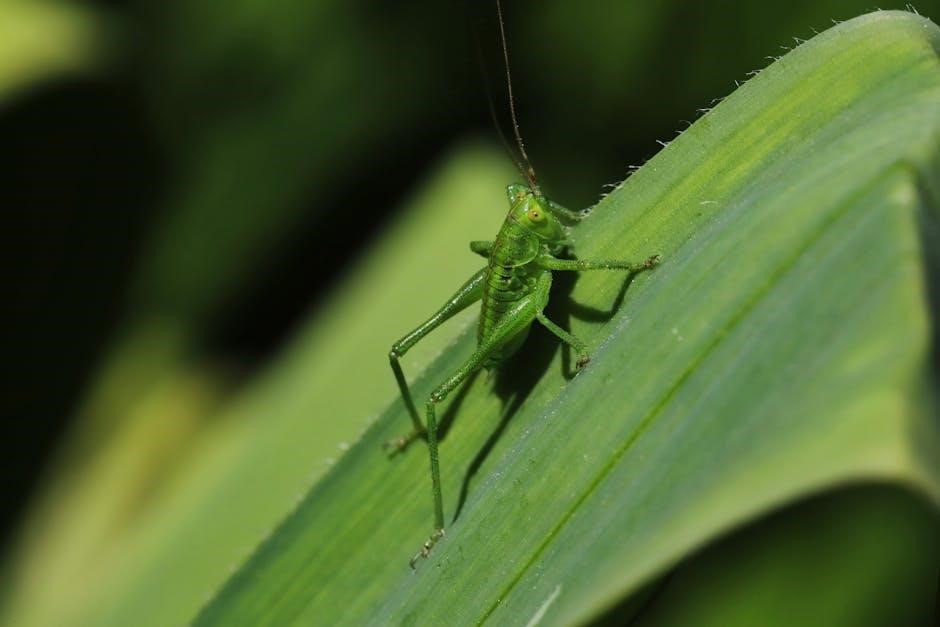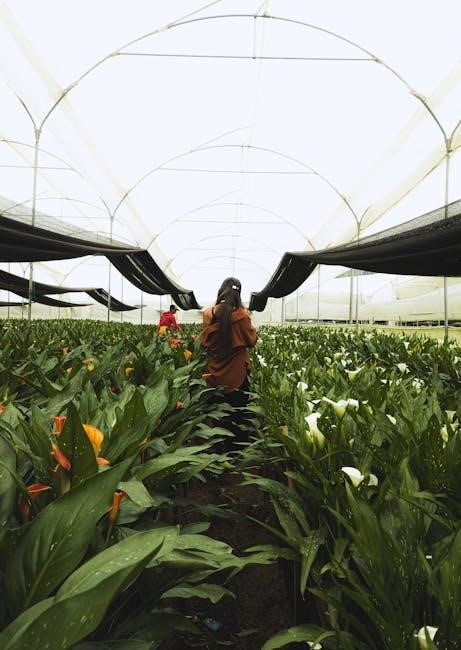Welcome to the Zone 8b Planting Guide! This guide helps gardeners navigate the unique conditions of USDA Hardiness Zone 8b‚ characterized by mild winters and a long growing season. With average minimum temperatures ranging from 15°F to 20°F‚ Zone 8b offers ideal conditions for a wide variety of plants. Whether you’re growing vegetables‚ fruits‚ or flowering shrubs‚ understanding the best planting times and practices is key to a thriving garden. This guide provides essential tips and schedules to maximize your gardening success in Zone 8b.
Understanding USDA Hardiness Zone 8b
USDA Hardiness Zone 8b is one of the plant hardiness zones designated by the U.S. Department of Agriculture. It is characterized by average minimum winter temperatures ranging from 15°F to 20°F (-9.4°C to -6.7°C). This zone has mild winters and a long growing season‚ making it ideal for a wide variety of plants. The last frost date typically occurs in mid-March‚ while the first frost date is around early December. These conditions allow gardeners in Zone 8b to grow both cool-season and warm-season crops‚ with ample time for plants to mature and thrive.
Importance of Timing in Zone 8b Gardening
Timing is crucial in Zone 8b gardening due to its long growing season. Planting too early or late can reduce yields or damage crops. Cool-season crops like broccoli and kale thrive when started indoors in late winter or early spring‚ while warm-season crops such as tomatoes and peppers should be planted after the last frost date in mid-March. Proper timing ensures optimal growth‚ prevents frost damage‚ and maximizes the harvest. Aligning planting schedules with Zone 8b’s climate ensures a successful and bountiful garden throughout the year.

Soil Preparation for Zone 8b
Proper soil preparation is essential for Zone 8b gardening. Opt for well-drained soil rich in organic matter. Adjust pH levels for specific plants to ensure optimal growth and health.

Best Soil Types for Zone 8b Plants
Zones 8b gardens thrive in well-drained‚ nutrient-rich soils. Loamy soil is ideal due to its balanced structure‚ retaining moisture while draining excess water. Sandy soils are suitable for root vegetables like carrots and beets‚ promoting healthy growth. Clay soils‚ though dense‚ can support shrubs and perennials like oleander and bougainvillea. Incorporating organic matter such as compost or mulch enhances soil fertility and drainage‚ ensuring plants receive essential nutrients. Proper soil selection and preparation are key to maximizing plant health and productivity in Zone 8b’s climate.
Fertilization and pH Balance for Optimal Growth
Fertilization and pH balance are critical for thriving plants in Zone 8b. Most plants prefer a slightly acidic to neutral soil pH‚ ranging from 6.0 to 7.5. A balanced fertilizer with a 10-10-10 NPK ratio is ideal for general gardening. Organic matter like compost or well-rotted manure enriches soil fertility and improves structure. Regular soil testing ensures optimal nutrient levels and prevents over-fertilization‚ which can harm plants. Adjustments should be made seasonally to meet the specific needs of vegetables‚ fruits‚ and flowering plants‚ ensuring robust growth and productivity in Zone 8b’s climate.

Planting Calendar for Zone 8b
Zone 8b’s long growing season allows for year-round planting. The last frost date in mid-March signals the start of outdoor planting‚ with opportunities for multiple harvests.
Spring Planting Schedule
In Zone 8b‚ spring planting begins after the last frost date in mid-March. This is the ideal time to plant warm-season crops like tomatoes‚ peppers‚ and zucchini. Cool-season vegetables such as broccoli‚ kale‚ and spinach can be direct-sown in early spring. Start seeds indoors for crops like lettuce and carrots 4-6 weeks before the last frost date. Succession planting allows for multiple harvests‚ ensuring a continuous supply of fresh produce throughout the season. Soil temperatures should be monitored for optimal germination and growth.
Summer Planting Schedule
In Zone 8b‚ summer planting focuses on heat-tolerant crops that thrive in warm weather. Plant okra‚ southern peas‚ and sweet potatoes in late spring to early summer for a bountiful harvest. Zucchini‚ squash‚ and corn also excel during this season. Ensure soil remains well-drained and mulched to retain moisture. Regular watering and full sun exposure are crucial for optimal growth. Herbs like basil and mint can be planted in containers for fresh summer harvests. Succession planting ensures a steady supply of vegetables and herbs throughout the season.
Fall and Winter Planting Opportunities
In Zone 8b‚ fall and winter offer opportunities to grow cool-season crops. Plant broccoli‚ kale‚ and spinach in late summer to early fall for a winter harvest. Garlic and onions thrive when planted in fall‚ maturing by summer. Winter flowers like pansies and violas can also be planted in early fall for vibrant color. Protect sensitive plants with mulch or cold frames to shield them from occasional frosts. This extended growing season allows gardeners to enjoy fresh produce and beauty year-round in Zone 8b’s mild climate.

Best Plants for Zone 8b
Zone 8b offers ideal conditions for a wide variety of plants‚ including vegetables‚ fruits‚ herbs‚ and flowering shrubs. Gardeners can enjoy a thriving and diverse garden year-round with proper planning and care.
Vegetables and Fruits
Zone 8b’s long growing season supports a wide variety of vegetables and fruits. Popular choices include tomatoes‚ peppers‚ eggplants‚ and leafy greens like lettuce and kale. Root vegetables such as carrots‚ beets‚ and radishes also thrive. For fruits‚ strawberries‚ blueberries‚ and blackberries are excellent options‚ as they tolerate the region’s mild winters and warm summers. These plants are adaptable to Zone 8b’s climate‚ ensuring a bountiful harvest when planted at the right time. Starting seeds indoors in early spring can give your garden a strong start.
Flowering Plants and Shrubs
Zone 8b gardeners can enjoy a vibrant array of flowering plants and shrubs that thrive in the region’s mild winters and warm summers. Oleander‚ bougainvillea‚ and lantana are popular choices for their colorful blooms and drought tolerance. Lavender and rosemary shrubs also excel‚ offering both beauty and fragrance. Plant these in well-drained soil and full sun for optimal growth. Shrubs like azaleas and gardenias bloom beautifully in Zone 8b’s climate‚ while perennials such as daylilies and coneflowers provide long-lasting color. These plants add texture and vibrancy to any garden‚ making them ideal for year-round enjoyment.
Herbs and Leafy Greens
Zone 8b gardeners can successfully grow a variety of herbs and leafy greens throughout the year. Leafy greens like spinach‚ kale‚ and lettuce thrive in cooler spring and fall weather‚ while herbs such as basil‚ mint‚ and rosemary excel in warm summers. Plant these in well-drained soil with partial shade for greens and full sun for herbs. Succession planting ensures a continuous harvest‚ especially for fast-growing greens. Herbs and leafy greens add fresh flavor and nutrition to meals‚ making them a staple in any Zone 8b garden.

Pest Management and Care Tips
Proactively manage pests like aphids‚ whiteflies‚ and slugs using organic methods such as neem oil and diatomaceous earth. Regular watering and pruning promote healthy plant growth and deter pests‚ ensuring a thriving garden in Zone 8b.
Common Pests in Zone 8b
Zone 8b gardens often face challenges from pests like aphids‚ whiteflies‚ and slugs. Aphids target tender shoots and flowers‚ while whiteflies damage leaves and spread diseases. Slugs and snails thrive in moist environments‚ feeding on plants at night. Other pests include caterpillars‚ spider mites‚ and root nematodes‚ which can weaken plant health. Regular monitoring and early intervention are crucial to prevent infestations and protect your garden’s productivity. Understanding these pests’ habits helps in applying targeted control measures for a healthier garden in Zone 8b.
Organic and Chemical Pest Control Methods
For effective pest management in Zone 8b‚ gardeners can use both organic and chemical methods. Organic approaches include introducing beneficial insects like ladybugs and lacewings‚ practicing crop rotation‚ and using natural pesticides such as neem oil and garlic sprays. Chemical controls‚ like insecticidal soaps and pyrethrins‚ target specific pests while minimizing environmental impact. Combining these methods ensures a balanced ecosystem and reduces reliance on harsh chemicals. Always follow label instructions and apply treatments at appropriate times to maintain garden health and safety in Zone 8b.

Extending the Growing Season
Zone 8b’s mild winters and long growing season allow for year-round gardening. Use greenhouses or cold frames to protect plants during cooler months and enable earlier spring starts.
Using Greenhouses and Cold Frames
Greenhouses and cold frames are excellent tools for extending the growing season in Zone 8b. Greenhouses provide year-round protection from frost and pests‚ ideal for starting seeds early or growing sensitive plants. Cold frames‚ while simpler‚ offer similar benefits on a smaller scale. Both structures allow gardeners to plant cool-season crops like broccoli and kale in late winter or early spring‚ ensuring a continuous harvest. By utilizing these‚ Zone 8b gardeners can enjoy fresh produce even outside the traditional growing season.
Succession Planting Strategies
Succession planting is a key strategy for maximizing yield in Zone 8b’s long growing season. Start seeds indoors in late winter for cool-season crops like lettuce and kale‚ then transition to warm-season plants like tomatoes and peppers after the last frost. Stagger plantings every 1-2 weeks to ensure a continuous harvest. This method prevents overwhelming abundance and keeps the garden productive year-round. By planning successive sowings‚ gardeners in Zone 8b can enjoy fresh produce throughout the growing season‚ making the most of the region’s favorable climate conditions.

Zone 8b Planting Schedule with Charts
Visual charts provide a clear timeline for planting in Zone 8b‚ ensuring optimal growth. Start seeds indoors by late February and transplant after the last frost in mid-March. These charts detail sow‚ plant‚ and harvest times for vegetables‚ fruits‚ and flowers‚ helping gardeners maximize their growing season effectively.
Visual Charts for Planting Times
Visual charts simplify planting in Zone 8b by providing a clear‚ organized timeline. These charts outline ideal sow‚ transplant‚ and harvest dates for vegetables‚ fruits‚ and flowers. They help gardeners avoid frost risks and ensure optimal growth. For example‚ start seeds indoors in late February for broccoli and tomatoes‚ and transplant after the last frost in mid-March. Charts also highlight variety recommendations and spacing tips‚ making it easier to plan and execute a successful garden. Printable PDFs are available for quick reference throughout the growing season.
Recommended Varieties for Zone 8b
Zone 8b gardeners can thrive with a wide range of plants suited to its mild winters and long growing season. For vegetables‚ popular choices include tomatoes‚ peppers‚ zucchini‚ carrots‚ and leafy greens like lettuce and kale. Flowering favorites like oleander and bougainvillea add vibrant colors‚ while herbs such as basil and rosemary grow abundantly. Fruit trees like figs and citrus also excel in this zone. Selecting varieties bred for heat tolerance and disease resistance ensures optimal performance. Consult planting charts for specific timing to maximize success in Zone 8b gardens.



